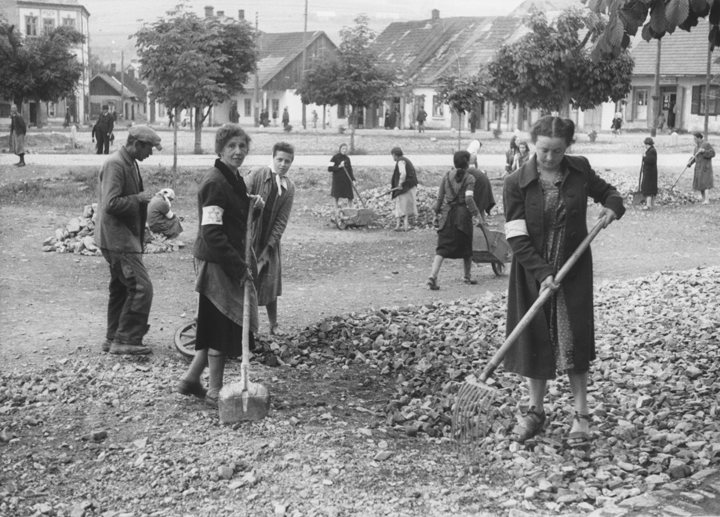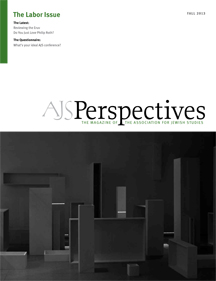
The city of Radom in central Poland was the headquarters of the Radom district, which was one of the four districts established in October 1939 to create the Generalgouvernement. The district was one of the three most important industrial areas in prewar Poland. About thirty thousand Jews lived in the city on the eve of the War, comprising 30% of its population. They were the economic backbone of the city, since they owned most of the small industries for which the city was known: tanneries; iron foundries; lumber mills; and furniture, shoe, enamel, and brick factories. They handled the majority of the city’s commerce. Yet, most Jews worked as artisans. Jews were not allowed to work at the state-owned armament factory, Vitornia Broni, which produced guns, the unique Radom pistols, the VIS, and bicycles.
From the first day of occupation, the Nazis exploited Jewish labor for various ends. Until the implementation of the Final Solution, Jews viewed this work as one of multiple forms of Nazi persecution. The “decree regarding the establishment of forced labor for Jews” was issued by the Generalgouvernement’s governor, Hans Frank, on his first day in office on October 26, 1939. Even before the official edict, young Jewish men were press-ganged to comply with exigent labor needs for the war and the organization of the new authorities’ headquarters. Nazis took Radom Jews from the streets to repair bridges; clear rubble; clean offices, stables and streets; and carry furniture. These violent kidnappings created an atmosphere of terror among the Jews, many of whom avoided the streets. One of the first requests made to the German authorities by the Radom Jewish council (the Judenrät), established in early December, was to provide a regular quota of laborers (labor commandos) in order to stop the kidnappings. Afterwards, it became one of its official tasks.
The Judenrät administered the enlistment of workers, and organized their payments. All Jews fit to work had to appear for duty twice a week. The workers were often young people whose studies or apprenticeships were disrupted because of the war. They worked as a replacement for older family members, who were the family bread winners, or in place of affluent Jews, who paid them as substitutes. They toiled in manual labor, some of which was temporary and some of which regular. The authorities were keen to employ both unskilled and skilled workers because they were paid less than the Poles.
The most severe forced labor for Jews at the beginning of the war was in labor camps established to build infrastructure. Jews toiled to pave roads, drain swamps, and divert rivers. Working and living conditions were poor. Many became sick or died. The Nazis also used the labor camps to alleviate the demographic problem in Radom. In early 1940, Radom became overcrowded. Local Jews who escaped to the Soviet Union at the beginning of the war returned. Deportees, Jews from the Warthegau, annexed to the Reich, and Jews from the surrounding communities found refuge in the city. The Germans responded swiftly. They expelled 1,840 “unproductive” Jews to other counties and sent 2,500 young men in two transports to various labor camps in the Lublin district.
Nevertheless, the crowdedness increased in the spring of 1941 when thousands of Germans came to the city in preparation for “Operation Barbarossa” (the invasion of the Soviet Union). This time the authorities reacted to the demographic crisis by crowding the Jews in two ghettos. In April 1941, 27,000 Jews were squeezed in a ghetto in the old city, and 5,000 Jews were packed in a ghetto in the Glinice suburb.
Despite the miserable circumstances in the ghettos, relatively, the economic conditions were not as bad as in other ghettos. Radom’s strategic location and the large number of Germans in town provided work patterns and “opportunities” for the Radom Jews. Most of them worked outside their confined living area, for the official authorities or for private industries. Among the occupying forces: the civil administration, the SS, and the military, the latter became the largest employer. It staffed Jews in transit bases, supply depots, a garage, a sewing workshop, and a military hospital established when the war expanded to the East.
Nevertheless, most Jews worked in small private industries held by Polish or German trustees outside the ghettos, since the lack of space within the Radom ghettos prevented the Germans from opening workshops inside. Jews also started to work in the local armament factory, which was owned by the Austrian firm Steyr-Daimler-Puch. Officially, Jews could only work for the war effort or for other Jews within the boundaries of the ghetto. But several dozen tradesmen and merchants, who served the personal needs of the German population, were able to keep their businesses and work in the private market both outside and inside the ghetto. Within the ghetto, the Judenrät was the biggest employer. Its police department, comprised of 128 policemen, was the largest, and its primary job was to accompany the workers from the ghettos to their work places and back every day.
In the spring of 1942 when rumors about the deportations from Lublin reached Radom, many started to look for work as a means to survive. Before being restricted in the ghetto, Jews tried to avoid compulsory work for the Germans, but suddenly work for the Germans became desirable. Indeed, during the August 1942 selections, the main criterion for staying in Radom was a work card authorizing work for the Germans. Although many workers met their death, those without cards were sent to Treblinka.
A new phase began for the five thousand Jews who remained in the town. Before the liquidations, the civil administration was responsible for the employment of all Jews and could assure wages for those who worked for any official authority. Now, the SS became the dominant power and provided no monetary compensation for Jewish labor. A limited number of Jews could work in military camps and in private factories, producing equipment for the military. Gradually, those Jews were killed, sent to work directly for the SS, or transferred to armament factories.
Jews worked for the SS in four main capacities: dealing with the byproducts of the Final Solution (collecting, sorting, and repairing merchandise left by deported Jews); auxiliary and maintenance of SS facilities (demolishing old houses, digging peat, and loading and unloading provisions); fulfilling the individual needs of the SS (cleaning, providing and maintaining household goods); or producing goods for the German population in town.
Following the campaign for increased armament production in 1942, Radom proved itself yet again as a valuable place for working Jews, since five of the eight most important military factories in the Generalgouvernment were operating in the district. In the summer and fall of 1943, while most Jews working in the Generalgouvernememt were massacred, Radom Jews were sent to work in the district’s armament factories. They lived in camps established near the factories.
The final stage of Jewish labor in Radom took place in January 1944, as Szkolna, the factory camp in the city, became the only concentration camp in the district. With the advancement of the Red Army in the summer of 1944, the camp was closed. Its 3,367 Jewish workers, considered experienced, were not killed, but rather were taken to Auschwitz, to be deported for work in other locations inside the Reich. They had to adjust to a new type of slave labor and harsher living conditions, while trying to continue to survive through labor and not be destroyed by it.
The notion of “work as a savior” held only for some of the Radom Jews, but was more the case in Radom than in other places. Radom Jews experienced various types of work during the war. Until the liquidation of the ghettos, Jews perceived work for the Nazis as persecution; after it, they viewed work as a means of survival. During the first years, Radom Jews were forced to work for the various authorities: the civil administration, the military, and the SS. They mainly worked in hard labor, often for little pay. Some could work in the free market. In August 1942 the SS received the jurisdiction of Radom Jews. Only Jews who contributed to the war effort could remain in Radom, and would not be deported. The Nazi labor policy towards the Jews became the Nazi policy towards the Jews. The SS enabled only Jews who toiled for the armament industry or for the SS to remain in town. The economic importance of Radom and the personal interests of its SS residents gave Radom work Jews some chance to survive through work.

